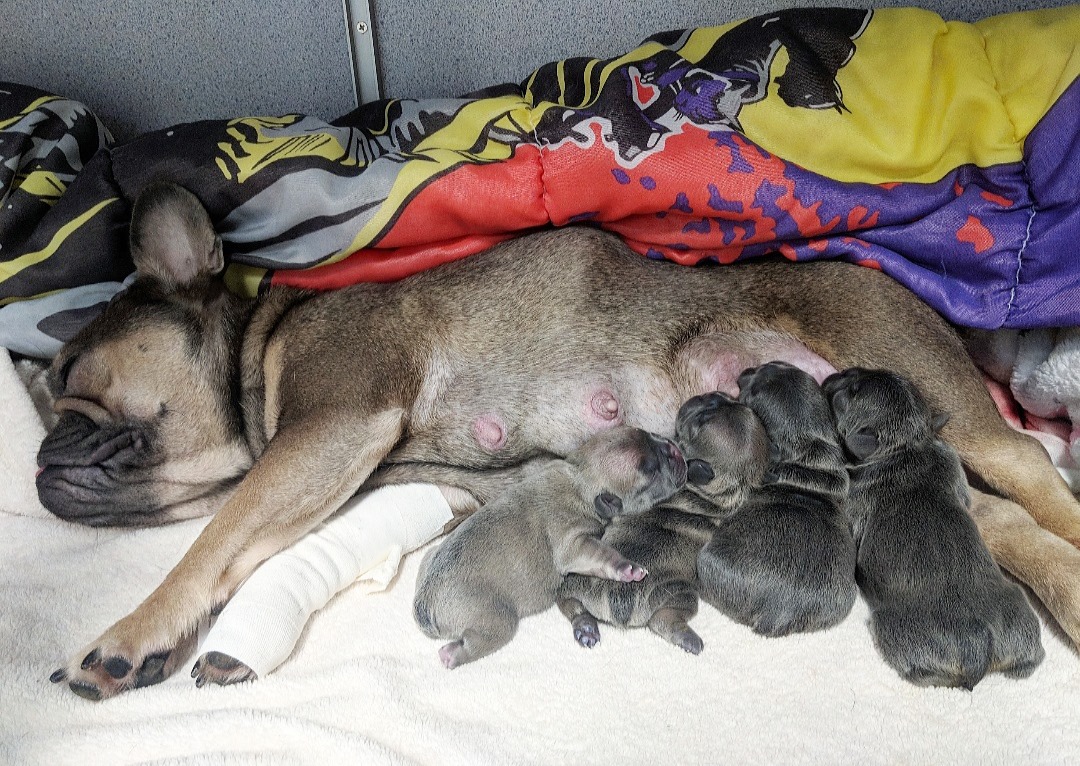Pregnancy in Dogs – Signs, Care, and When to Go to the ER

Spaying and neutering are recommended for nearly all pet dogs. So, many dog owners are blissfully unaware of the breeding, pregnancy, and whelping process. However, accidental pregnancies may become more common now that many veterinarians recommend spaying and neutering later in life for health reasons.
If you find yourself caring for a rescued pregnant pup, your dog is accidentally pregnant, or you plan to responsibly breed your dog, understanding dog pregnancy is vital to keep the mother and her puppies healthy.
Adding to your Dog’s Family
Should you breed your dog? You’ve probably heard conflicting arguments. Some suggest that allowing your female dog to go through a heat cycle or have puppies prior to spaying is the way to go. This can have some benefits, including reduced incidence of spay-related incontinence and fewer joint problems in large breeds. However, no evidence suggests that having puppies is beneficial.
Caring for a pregnant dog and an entire puppy litter is expensive and time-consuming and best left to experienced breeders. Before you go ahead and breed your dog, consider the complications that can occur before, during, or after pregnancy, and intact dogs are more likely than spayed dogs to develop mammary cancer or life-threatening uterine infections (i.e. pyometra).

A 3-year-old Border Collie who presented to Veterinary Specialty Hospital- North County to find out how many puppies she was expecting via ultrasound & radiographs. She ended up birthing 7 healthy puppies!
How to Tell if my Dog is Pregnant
Female dogs go through heat cycles that prepare them for pregnancy twice yearly. Behavior clues and blood tests can determine when a female dog is expected to ovulate. Whether or not she is successfully bred, she could develop pregnancy signs shortly after because of hormonal changes that occur after ovulation. False pregnancy resolves on its own without medical treatment. These are signs of a real or false pregnancy:
- Weight gain
- Mammary gland development
- Tiredness
- Possible vomiting or decreased appetite
- Nesting behavior (ripping up/dragging blankets to a new place, rearranging pillows, gathering toys in a designated area)
Pregnancy can be confirmed with ultrasound, and the puppy number can be determined later in the pregnancy using radiographs (x-rays) to count skeletons. Blood or urine testing does not accurately detect or confirm pregnancy in dogs.

An x-ray confirms 7 French Bulldog puppies removed successfully via c-section at SAVES.
How Long is a Dog’s Pregnancy
The official time of pregnancy for dogs is 63 days from ovulation. Ovulation can be determined using blood tests, but if you aren’t sure about the date, you can expect puppies 58 to 68 days after breeding. Monitoring the mother’s behavior and body temperature, which will sharply drop within 24 hours of whelping (i.e., birth), can help to determine when she’ll go into labor.
Caring for a Pregnant Dog
Seek out a veterinarian who specializes in reproduction (theriogenology) early in your dog’s suspected pregnancy to ensure she receives the best care. As with pregnant humans, your pregnant dog will need regular health checks and ultrasound examinations to ensure she does not develop complications. Your veterinarian can also advise or assist during whelping and perform a C-section if needed. Some brachycephalic breeds, such as Bulldogs, cannot give birth naturally and must have a carefully timed, planned C-section.

A French Bulldog who had dystocia (difficult birth) when a puppy got stuck in the birthing canal. All 4 of her puppies were delivered via emergency c-section at Bulger Veterinary Hospital.
Dogs’ vaccinations should be up to date prior to pregnancy because the mother’s antibodies will provide vital disease protection during the puppies’ first few weeks. If the mother is unprotected, the whole litter risks severe illness or death from infectious disease. Vaccinating during pregnancy is usually not advised, but protecting puppies from parvovirus and distemper may take precedence over vaccine risks, which only a qualified veterinarian can determine.
Pregnant and lactating dogs need extra calories and nutrient-dense food to provide adequate nutrition for the puppies. You can purchase a special diet for pregnant dogs or one formulated for puppies. Do not use large-breed puppy food, as the mineral balance is not appropriate for pregnant or lactating dogs.
What to Expect During Whelping (Labor & Birth)
You should provide your dog with a whelping box, which is a comfortable, easy-to-clean space that contains the puppies, but allows mom to come and go. She will instinctively nest prior to labor and give birth in this space. You’ll notice your dog become restless, refuse food, and possibly vomit during initial labor contractions that can last up to 12 hours.
After this first stage, your dog will strain for 10 to 15 minutes to pass the first puppy, and then pass the afterbirth about 15 minutes later. The next puppy usually comes 30 to 60 minutes later, but may take up to two hours. The mother dog will remove the sac and umbilical cord from each puppy and lick them to stimulate breathing. Your veterinarian can advise you on what to do if the mother does not perform these behaviors, as you may need to step in and help.
When to Seek Emergency Veterinary Care
Dogs who have problems birthing are experiencing a medical condition called dystocia. The mother needs emergency care if you notice the following:
- Straining for longer than 15 minutes and not passing a puppy
- Membranes visible in the birth canal and no puppy in 15 minutes
- Longer than two hours between puppies
- All puppies haven’t passed within 24 hours
More health issues can arise after whelping, including infections and a low calcium level (eclampsia). Call your veterinarian if you have any concerns about your dog’s behavior, but especially if the mother:
- Has pus or foul-smelling vaginal discharge (reddish brown discharge is normal)
- Is having muscle spasms or seizures
- Has a poor appetite
- Is feverish
- Is not producing milk
- Is not caring for her puppies
- Has swollen, red nipples

A Great Dane who had an emergency c-section at Atlantic Street Pet Emergency Center. After birthing 8 puppies and an unsuccessful night of continued labor, her owner brought her to the ER to birth the last 3 puppies.
Breeding your dog and caring for puppies can be extremely rewarding. But, pregnancy carries health risks such as serious—or deadly—pregnancy and postpartum complications, so working with a qualified veterinarian is essential. Seek veterinary care with an Ethos Veterinary Health or other veterinary facility if you have any concerns regarding your dog’s pregnancy or postpartum care.